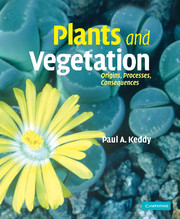Book contents
- Frontmatter
- Contents
- Preface
- Acknowledgements
- Chapter 1 Plants and the origin of the biosphere
- Chapter 2 Description of vegetation: the search for global patterns
- Chapter 3 Resources
- Chapter 4 Stress
- Chapter 5 Competition
- Chapter 6 Disturbance
- Chapter 7 Herbivory
- Chapter 8 Positive interactions: mutualism, commensalism, and symbiosis
- Chapter 9 Time
- Chapter 10 Gradients and plant communities: description at local scales
- Chapter 11 Diversity
- Chapter 12 Conservation and management
- Questions for Review
- References
- Index
- References
Chapter 5 - Competition
- Frontmatter
- Contents
- Preface
- Acknowledgements
- Chapter 1 Plants and the origin of the biosphere
- Chapter 2 Description of vegetation: the search for global patterns
- Chapter 3 Resources
- Chapter 4 Stress
- Chapter 5 Competition
- Chapter 6 Disturbance
- Chapter 7 Herbivory
- Chapter 8 Positive interactions: mutualism, commensalism, and symbiosis
- Chapter 9 Time
- Chapter 10 Gradients and plant communities: description at local scales
- Chapter 11 Diversity
- Chapter 12 Conservation and management
- Questions for Review
- References
- Index
- References
Summary
Brief history. Definition. Costs of competition: stress and strain. Intra- and interspecific competition. Competition intensity. Effect and response. Dominance. Monocultures. Asymmetry. Hierarchies. Mycorrhizae. Competition gradients. Old fields, prairies, alvars, wetlands, and mountainsides.
Introduction
The importance of competition
More than a century ago, Malthus and Darwin both appreciated the intrinsic nature of organisms to multiply exponentially against limits set by resources and saw that this produced a struggle for survival. Thomas Malthus (1766–1834) was an English economist and clergyman; Charles Darwin (1809–1882) was, of course, the English naturalist who, along with Alfred Wallace, proposed the theory of evolution through natural selection. The capacity for exponential growth means that both houseflies and elephants, given sufficient time, could multiply rapidly enough to entirely cover the land area of Earth. Given a few more generations, a ball of flies or elephants would then expand outward from the Earth's surface and eventually reach light speed; the flies, being more fecund than the elephants, would, of course, have a head start. Darwin used a human example in The Descent of Man and Selection in Relation to Sex (1871):
Civilised populations have been known under favourable conditions, as in the United States, to double their numbers in twenty-five years; … the present population of the United States (thirty millions), would in 657 years cover the whole terraqueous globe so thickly, that four men would have to stand on each square yard of surface. The primary or fundamental check to the continued increase of man is the difficulty of gaining subsistence [resources].
(pp. 275-276)- Type
- Chapter
- Information
- Plants and VegetationOrigins, Processes, Consequences, pp. 186 - 224Publisher: Cambridge University PressPrint publication year: 2007



